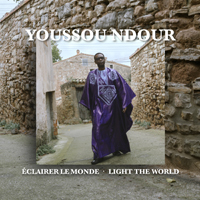
YOUSSOU N'DOUR
ECLAIRER LE MONDE / LIGHT THE WORLD (TBI Publishing)
Many of us grew up with Youssou Ndour, which is to say, when we got into African music the Etoile de Dakar were flying high and they toured the world, spreading mbalax music to eager fans. Youssou eventually returned to his hometown of Dakar, Senegal and served as Minister of Culture. But for this album he forsook his home studio where he records up-and-coming bands, and travelled to Barcelona, Spain to record with producer Michael League of Snarky Puppy (I have no idea what that is). The result is massive: very strong percussion, spare instruments and Youssou's powerful voice to the fore. According to an interview with Banning Eyre, Youssou wrote the songs over the past two years, and says it's about his confidence in humanity in the post-Covid era.
Over the years we have learned of Youssou's involvement in the Mouride Sect of Islam, with songs like "Shukran Bamba" on his masterpiece album Egypt. Several other great Senegalese singers are also adherents, so his name, if not his teachings, have become familiar to us. Also here is another song, called "Sam Fall," about Cheikh Ibra Fall, leader of the Baye Fall, delivered simply and honestly with only acoustic guitar backing. Youssou admits that often he would let the electric guitar replace all the traditional instruments, filling the space left by xalam, kora and balafon with electric amperage. Interestingly, Youssou's right-hand man, Mamadou "Jimi" Mbaye, his lead guitar player for decades, died in February 2025. But here the traditional instruments, including njarka, return. There's a slight irony in the song "Mbëggèl doole" which Youssou says is inspired by his love for Orchestra Baobab. The older Latin sounds that characterized groups like Baobab were swept away by the youngsters and their mbalax in the 70s, and that is why Baobab and many others broke up. The guitar solo on here is more US white boy blues-inspired, but then no one could come near the brilliance of Baobab's Barthelémy Atisso, so I'm glad the snarking puppy did not try. Despite some embarrassing forays into English (the awful and skippable "Tell me what you want" and the chorus to "On l'a fait"), this is a strong new album from the mighty Youssou. "Say thank you" has the classic Etoile energy with the anthemic call and response vocals and "everybody wave your hands in the air" energy of the big stadium shows he used to enjoy. He winds down the perfectly paced disc with another praise song for his spiritual guru, "Ahmadou Bamba," and leaves the last note to the traditional instruments.
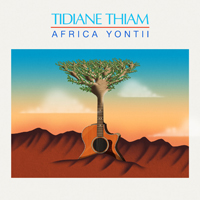
TIDIANE THIAM
AFRICA YONTII (M. N. Records)
This album is a very mellow outing of mainly acoustic guitar from northern Senegal, called "It's Time." Occasional looped percussion or an electric guitar joins in (Samba Ba, on two tracks), but also ambient noises, such as night sounds, insects, and birdsong. I read in the Guardian that we just passed the centenary of the first remote live broadcast. Apparently there was a lady musician in England who liked to play her cello in the garden of an evening, and to her surprise, a nightingale in the neighboring woods joined in. The BBC heard about this and sent a sound truck with engineers to her place and they set up mikes and a transmitter and it was broadcast live over the air: an event which many people who heard it remembered for a long time. Today it may seem unsurprising to have a live recording from a remote village in West Africa, but nevertheless the ambient noise still reminds us of the tranquility of an evening as musicians relax and jam. There is a video shot to accompany the song "Yeewende," linked on bandcamp. The track "Yangue" surprised me because it is a well-known set of chords (E D A E; A G D E), in the english folk tradition, which has been recorded as "If I were a Carpenter," "Morning Dew" and other popular songs. The notes tell us the album was recorded in a studio, where perhaps the ambient sounds were added, indicating the massive changes in recording technology since the mobile truck strung wires to the English lady's garden. However, it's a night passed with pleasure in the global village.
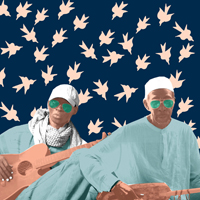
AMADOU BINTA KONTE & TIDIANE THIAM
WAANDE KADDE (Songs from Home)
As I was on Tidiane Thiam's bandcamp page, I saw another album that looked intriguing, a duet with Amadou Binta Konté featuring the latter on hoddu (a relative of the ngoni). I let it play, which is still one of the great delights on bandcamp, as there are no ads and they only bug you to buy after you have given something a couple of auditions. Anyway, it lifted off into orbit and by the last track, the 18'33 magnum opus "Guilly," I was sold. A group of bystanders starts to clap to keep a rhythm as the two musicians go into a trance; at times it reminded me of Coltrane's "A Love Supreme." Yes it is intense! Furthermore, it was listed as "pay what you like," so I figured it was ten bucks well spent to encourage their musical efforts. Thiam is billed as a guitarist, folklorist, photographer and visual artist, so he is a thoroughly rounded talent. He comes from Podor, a small riverside fishing village in the far north of Senegal. The tracks are dreamy and open-ended, beginning and ending without resolution; the album, recorded in 2014, was selected to launch a new venture from Mississippi Records and Sahel Sounds called Songs from Home. It's been around a while, but don't miss it.
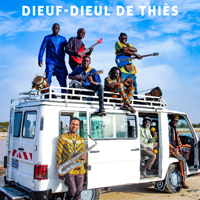
DIEUF-DIEUL DE THIES (Buda Musique CD 860390)
Dieuf-Dieul means "give/receive" or put another way "You reap what you sow." Mouridism and Christianity, it turns out, do have some moral tenets in common. In this case the germination between sowing and reaping was over 40 years. During that time, Dieuf-Dieul remained the greatest Senegalese band no one had heard. Those who had seen them perform in a nightclub in Thiès insisted they had no equal. This is in fact what led Adamantios Kafetzis to track down the two known extant tapes that the band had recorded in 1979. Starting around 2012 Kafetzis' label Teranga Beat released a dozen albums of exceedingly rare previously unheard Senegalese recordings he had found. Some were artists we knew like Dexter Johnson or Mar Seck; others complete unknowns. However Dieuf-Dieul were a total stunning surprise: the as-advertised legendary band, formed by Pap' Seck, famed lead guitarist of Guelewar and Ouza et ses Ouzettes. On a trip to Thiès, some Ouzette band members stayed behind and soon were jamming with local teenage musicians, including singer Bassirou Sarr. They created a new hybrid, with elements of the popular Cuban-inspired sound but also rock guitar leads and mbalax drumming. They also encountered a famous griot, Gora Mbaye, who performed with them, bringing his legions of fans to see them, and then on tour they encountered Assane Camara, a salsero who brought his modern Latin style to their stage shows. Clearly, at their peak they were a strong rival to Super Etoile de Dakar. In addition to psychedelic guitar and Latin beats, they had a powerful and soulful quartet of horn players: trumpet, trombone and two saxes to lift them to the next level. The term Afro-Jazz best describes it: the loping timbales-driven beat of "Djirim" is reminiscent of Baobab but has an astounding trombone throughout. But eventually Pape Seck was poached by Baaba Maal and the band broke up. Decades later, those two albums on Teranga Beat electrified us and led to the inevitable calls for a reunion. Only Bassirou Sarr remains now, but he put together a new group of musicians to learn the old repertoire and create some new songs too. This is a great reminder of what might have been, but still engages us as mesmerizing Manding music of the highest calibre. They even cover Baaba Maal's "Galo," as the first single off the album. Inevitably they draw comparison with Orchestre Baobab and their live performance of "Alin na Djime" (which includes the lyric "On verra ça"), bears it out: they are up there among the greats.
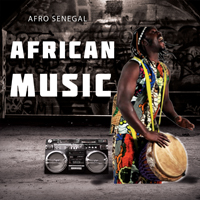
AFRO SENEGAL
AFRICAN MUSIC (La Timba 2000)
This compilation contains old-style Senegalese salsa from two artists, Maestro Keita and Camou Yandé, with a bonus track thrown in by Maguette Ndione, "El Divorcio," which was on her 2009 Homage to Labba Sosseh album. These are all familiar numbers, in fact right at the start we hear "El Carretero," which must be the first tune every Senegalese salsero learns. I think it always works well with the sabar drums. In addition there is piano and violin, perfect charanga components, though otherwise alien to Senegalese music. If you like Star Band, Baobab, No 1 and other classic Latin cover bands from Dakar in the 60s and 70s, you will dig this. My favorite compilations in this genre are Soneros et Salseros du Senegal, which came out on Bellot Records in 2005, and the older Escale au Senegal (a French release, from the 90s, compiled by Richard Dick.) There is no info online about Maestro Keita: he could be the Malian singer Léon Keita or his brother Germain. There's an Ivorien release on Papa Disco from 1978, which might be a link. Based on their voices and a youtube live video from 2015, it's clear these are veterans of the golden days who have been keeping the flame burning of this once-ubiquitous Cuban sound in West Africa. When Camou Yandé's "African Salsa" came on I knew I had heard this before. I checked the obvious source, Los Afro-Salseros' two CDs on Popular African Music where "African Salsa" appears, but actually it was on a third PAM disc, Nicolas Menheim & le Super Sabador's Commandante Che Guevara, where I found him. Camou Yandé is credited as conguero and lead vocalist on two tracks. He also covers Super Cayor's "Capitale." The various backing bands are solid, with neat horn solos, decent montuno piano styling and of course great congas and timbales.

MOMI MAIGA
NIO (Microscopi)
An initial reaction to this album is likely to be "Another kora album, oh, so how does it differ from all the others?" Well, it differs in terms of accomplishment and arrangement. Maiga is Senegalese and self-taught on the instrument. Here he is accompanied by violin and cello which suit the mood perfectly, and then various guests drop by with guitars and vocals to keep it interesting. It is fusion but it also situates the kora perfectly as a classical instrument in a string trio. The fine recording also brings out the percussion which is varied and not just a slapped calabash but a complex of subtle rhythmic additions. There are jazz and Spanish tinges from other accompanists which also keep it from going on the nod. As a youth, Momi Maiga was sent to live with his uncle's family in Casamance, in the south of the country. His uncle is Solo Cissokho, the virtuoso kora player, and the lad was so interested the uncle had a custom-made small kora built for him, on which the boy learned at home. He also accompanied his uncle on percussion at concerts so literally grew up in the music of his ancestors, the Mandinka repertoire. Invited to Spain to perform, Momi resettled there, which explains the buleria rhythms and flamenco singing on here. The ten tracks are very varied and provide a warm, well-rounded musical experience.

GUTS
ESTRELLAS (Pura Vida Sounds)
Estrellas (i.e. a cast of thousands) is a collaboration of Cuban and Senegalese artists, something we have enjoyed sporadically over the years, particularly on Popular African Music's Afro-Salseros album. In May 2021, during lockdown, Cubans came to Senegal to jam with local and French musicians on originals and standards. There is also a strong Cadence element from the French Antilles. Afro-Cuban vocalist Brenda Navarrete sings "Déjame en Pa (Leave me in peace)," with a small combo, including a fine (uncredited) pianist. You'll know "Adduna Jarul Naawo" as Baobab's "Dée moo wóor," which adds piano and an attempt to cop the atmospheric guitar of Bathelemy Atisso, but this is an impossible task, and ultimately a limp and loungey cover, despite the strong vocals by Alpha Dieng and Assane Mboup. "Il n'est jamais trop tard," is a cover by El Gato Negro of Bembeya Jazz's "Doni doni" that improves as it goes on. The horns are noteworthy. Brenda Navarrete returns for another highlight, a duet with David Walters, on "Por qué ou ka Fè sa," which is again in Haitian kriyo ("Why do you do that?"). Once again, we can listen before we commit, thanks to Bandcamp! There is some good noodling, some forgettable parts (the rap on "Barrio"), some truly awful songs ("Sin Pantallas"), but overall this set is worth skimming through, at least.

NURU KANE
MAYAM (Tchekchouka)
Nuru Kane returns with another grooving set of his Baye Fall-inspired music from Senegal. Google will lead you to several free download sites; I don't know if this was his intention, but it's there for the taking. The Baye Fall is a Mouride sect of Sufi followers of Amadou Bamba, the nineteenth-century mystic. To them, all humble work is a devotional act (as it should be). Kane plays guitar, bass and guimbri, a three stringed bassy instrument associated with the Gnawa farther North in Africa, but now widespread in the Sahara (and probably Europe where I think he is based). There's a smorgasbord of styles here, including fiery mbalax on "Welcome," reggae, and Casamance folk that veers into rap on "Atomik." He has one sound effect in his group, an early synthesizer, that forcibly recalls Edgar Winter's White Trash which may be cute but dates it terribly. His strained and histrionic singing in "Tengkoy" doesn't help, but he has catchy hooks. However bringing in a kazoo on "Djerejef," which is already packed with rock guitar, flute, marimba, and "megaphone" mike is overkill. There is some good musicianship on here, and he probably does a great live show, but it seems like they are trying to throw as many ideas as possible into one CD in the hopes of catching a wider audience. Straightforward tracks like "Yakar" are the most effective. The title, "Mayam," means "resources" in Wolof, and here he has gathered together rock and roll with mbalax and a load of other influences from gospel to gnawa: it's tasty in bites but overall may lead to indigestion.
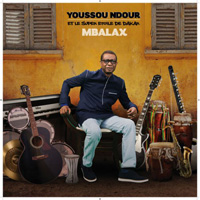
YOUSSOU NDOUR
MBALAX (Universal Music Africa)
It's been two years since Youssou N'dour's last album, a period of reflection, for all of us, locked down at home. However he has a recording studio in his house and has a parade of young bloods coming by to wax their own tracks and keep him abreast of musical development is his hometown of Dakar. To the traditional mbalax sound that he pioneered with his group Etoile de Dakar, he has grafted on elements of stadium rock and Latin salsa (so far no Hip Hop, grâce à Dieu). The old Cuban-tinged Senegalese music of his peers like Baobab and the original Star Band was indeed the sound that the polyrhythmic intensity of mbalax swept away. He used to put out twin releases, one for the domestic African market (rawer and more drum heavy) and one for the Western fans (with the rock sound and synths), but the two styles eventually merged. The latest album starts quietly with synthesizer strings, incongruous kora (yes it's a West African instrument but I think of it as a chamber or solo sound and not part of a large rock ensemble) and then horns and trap drums underpin the big sound he developed touring with Peter Gabriel in the 1980s. Electric guitar and massed tama and conga drums quickly assert themselves and fortunately he has the voice to stay on top of it all. By now the drone of the synth and the occasionally tinny lead which resembles no known musical instrument are a little tired, a musical security blanket that Youssou falls back on. When he toured he relied on his guitarist and tama drummer on stage but now, in the studio, he can tinker and layer and this cocoon prevents us hearing the essence of his music. He does get there eventually, but it's through a sonic haze. His singing and songwriting are still strong but an unplugged album would really clear away the cobwebs.
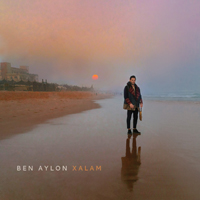
BEN AYLON
XALAM (Riverboat TUGCD1130)
This is remarkable: Ben Aylon is an Israeli musician who traveled to Dakar seven years ago to study the traditional sabar drum, with the son of the great Doudou Ndaiye Rose as his teacher. He became so proficient he was soon gigging with the likes of Youssou Ndour. He developed a technique for playing ten drums at once, to make the sound of a whole troupe of drummers! He was greatly influenced by the takamba ceremonial music of Gao. He then went on to study ngoni, xalam (another ancient stringed instrument) and other traditional West African instruments. His one man show was televised in Senegal and led to him performing with Cheikh Lô (an incredible drummer himself), Omar Pene and Doudou Ndiaye Rose. For his debut album Aylon plays the xalam, as well as sabar, various ngonis, synth and electric bass. He explains the reason for the title of his album: the word is also the root of the Hebrew word for "dream." The line-up is as impressive as Aylon's career, for he managed to record two separate Malian divas as he encountered them in his travels. Amy Sacko sings "Alafia" (recorded in Gibraltar) and he recorded the late Khaira Arby in a hotel room in Worms, Germany, in 2015. His third diva, is Aviva, an Ethiopian singer, stretching the sound across Africa to the East coast. The tracks with these guest vocalists are exceptional, like he is flexing every muscle to come up to their level. This is another great discovery from Riverboat.
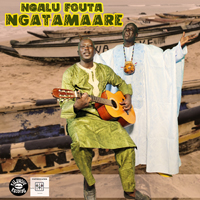
NGATAMAARE
NGALU FOUTA (Palenque Records)
Ngatamaaré is a group from the Fouta region of Senegal. They are Diola, the same ethnic group as Baaba Maal (who produced their first album in 2003 and, if you remember, released an album called Firin in Fouta), and have sonic similarities to him and also (to my ears) the classic Casamance band Touré Kounda (from the South), but that is more my western preconceptions reacting to the high voice on echo over the tama drums and interwoven rhythms. They come from Northern Senegal and Mauretania. Their name Ngatamaaré means the big rain that comes to end a drought. The group was formed in 1997 by two young men, Saly Diawu and Harouna Diop, who have returned to the traditional sounds of their Peulh ancestors, with calabashes, guitar and I also hear ngoni. In fact I think I hear two ngonis on "Noua" dueling with the guitarist. Like Touré Kunda there is a spiritual quality, sort of an endless twilight time that illuminates their sound. And then there is the frantic tama drumming we associate with early Youssou Ndour, who is from another ethnic group entirely! So despite my confusion as to where in Senegal this sound originates, I am really enjoying their fresh attack on the traditional music of the Peuls and other ethnic groups (Yella, Wango, Ripoo and Nallé are mentioned in the notes); their energy is sustained throughout and the drummers keep them going. Bits of ambient sound float in and out and the acoustic guitar is clean and clear. It's not all frantic and they settle down to deliver a well-rounded heartwarming set.
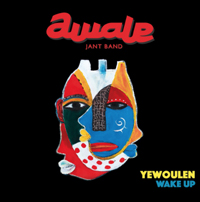
AWALE JANT BAND
YEWOULEN (ARC Music EUCD2885)
Biram Seck is a singer/songwriter who hails from Dakar. Son of a traditional Wolof storyteller, he is endowed with a fine soulful voice. Relocating to London he met a French jazz guitarist, Thibaut Remy, and they decided to merge their bands, creating a classic Afrobeat fusion. In fact they have played with Tony Allen, doyen of the genre. Here the drums are mainly the traditional sabar from Senegal (two of them), with jazz elements coming from the sparkling horns, trumpet and sax, and the guitar. Plus there are several guest horn players to beef up the arrangements. Their influences vary from Fania All Stars to Ethiopian jazz to traditional Senegalese bands like Thione Seck or Etoile de Dakar, but the overwhelming feeling is of West African afrobeat. Normally I would pass on this type of retro mixture, but there is some excellent soloing, strong songwriting, and as I say Seck is a very good singer.
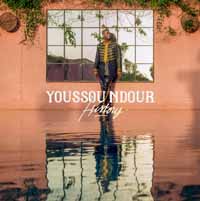
YOUSSOU NDOUR
HISTORY (Naive Records)
I am trying not to sound like a cranky old sourpuss. I did not review the Salif Keita album Another Blank, which came out last October (on the same label) and was touted to be his final statement (with a grand farewell tour in the manner of Elton John or other rolling stoners). Youssou is now a grand old man too, though I remember what a bright lad he was on his first US tour when he came by the radio station in a little college on top of a hill in San Francisco and dutifully answered the same old questions put to him by yours truly, a novice young broadcaster. Now he looks back over 35 years with portentous remakes of some of his favorite tracks, many first issued on cassette and sold in the streets of Dakar and then bootlegged in ever-diminishing quality. The opener is a tribute to Habib Faye, longtime sideman in his band, but it is loungey with easy-listening horns and not a promising start. Seinabo Sey (proponent of Scandinavian electro-soul) takes over vocals on the second track, "Birima," which is so depressing I had to take it off. Again there's angst-laden synths and this time an intrusive drum pattern. Where's Youssou? Oh here he is singing harmony in English, not his strong suit. Then he wails on echo... how much more of this can I stand? I liked Peter Gabriel back in the days of "Biko" but that big room over-production where every instrument has its own echo chamber, is really ponderous. Youssou's songs are "reimagined"; I would have preferred to hear them recreated. To fans in Dakar the cassettes were just a byproduct of their experience of the band, which they saw in clubs and stadiums; to fans in the West however, the same cassettes became talismata, however imperfect, of an emotional atmosphere they longed to get inside. The poor sound made you ache for it to open up so you could hear the tama, see the robes flapping as the dancers bucked on the stage, driven by the music. But without looking back, globetrotting Youssou goes off to Nigeria to refigure a couple of tunes by percussionist Babatunde Olatunji. In this he also follows Keita who had Ladysmith Black Mambazo and Angelique Kidjo on his "final" album. "Macoumba" returns to the mbalax sounds of Dakar that made Ndour famous and we want to hold the moment, have it blossom into a full album. It's worth holding out to hear this one, but then the "Kenny G of Cameroun" Alain Oyono returns & they put Youssou back into the echo chamber. And it does get worse, "Hello (remix)" is another English-language song this time by Congolese-Swede Mohombi, with added wailing from Youssou. It must have escaped from the Eurovision song contest, on its hands and knees. This album is all over the map, sadly it doesn't stop long enough in Dakar to get any traction. I often lamented the influence of Peter Gabriel on Ndour, but then his 2004 album Egypt, on Nonesuch, showed he could turn his vocal talents to the good with the right material. It's a shame his history is so tainted with the mediocre pop traces of his success.
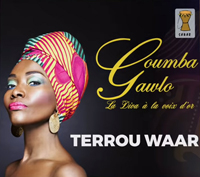
COUMBA GAWLO
TERROU WAAR (Sabar)
Not unlike an aging rocker, Salif Keita announced his retirement with a final album along with a farewell tour. Sad to report his farewell album is just an attempt to recapture his glory moment from 1987 when his breakout album Soro, produced by Ibrahim Sylla, brought synth and euro-horns to his traditional West African sound. I cannot listen to it. Thirty years later I am sick of the sound of synth washes and sampled instruments. There's no doubt the West African sound certainly has evolved and needs to continue to grow but there is still room for traditional praise-singing as heard on the opening cuts from this strong album from Coumba Gawlo Seck. The ubiquitous Sylla launched her career in the mid-90s when the Senegalese singer was still in her early 20s. Next to Youssou Ndour she is the best-selling artist in her homeland. Her new album showcases folk music, pop music and what I would call light jazz. This is an unfortunate development, after a strong opening when she gets to "Na," the fourth track, and Kenny G-type sax playing intrudes, along with the shrill Peul flute, it's over the top. Pop is up next with "Diombadio" which also has a traditional fiddle player behind the big band. "Rokale," "Borom Ndaam" and "Ngoulok" remind me a lot of the Salif Keita sound I was complaining about above. However the latter turns into a jam on the sabar drums and I suspect she is a fine dancer and they can tear this up in performance. "Tekk Gui" is more of a breathy French ballad, with echoey keyboards and bird sounds, the sort of thing that made us think Baaba Maal had lost the plot. More atmospherics kick off "Naby" which leans towards the "tinkly arabesque" sound Youssou captured on his Sufi album, Egypt. This is a good showcase for her voice and smartly they held it back (so she wouldn't get hoarse?) to show what she is capable of, after the tepid mid-section of the disc. The closer "Allez Africa" is another very light pop ditty with a heavy bass bomp to get the French-speaking punters waving their hands in the air.

BAO SISSOKO, MOLA SYLLA & WOUTER VENDENABEELE
TAMALA (Muziekpublique)
This trio was formed in the Low Countries, far from the hot deserts of West Africa. Yet they retain the arid raspy vocals and the sparkling strings reminiscent of glistening drops of water evaporating in the bright sun. The two Africans are Senegalese and brought their traditions into exile in Europe. There they hooked up with violinist Wouter Vandenabeele in Brussels, the international crossroads of Belgium. Like other successful fusion albums, the violin fits in perfectly with the plangent kora of Sissoko and the other strings plucked by Mola Sylla. He plays the small ngoni-like xalam and thumb piano on two tracks. The band name Tamala means Travelers, which has far pleasanter connotations than Refugees. However they sing about the plight of slaves in the striking number "Kongoman" which refers not to Jamaican music but to the kalimba which was brought to Senegal by slaves en route to the New World. The violin soars and evokes the big "Egyptian" sound that Youssou admired in the music of Oum Kalthoum. In the heart of the album, the violin leads the line on the instrumental "Ceppe" and "Zanzibar" which is a tribute to Bi Kidude, the late taarab singer. Kora and xalam intertwine on "Geej DJu Malika" a song about Malika the town near Dakar where Sylla goes to the ocean for inspiration. Vandenabeele plucks his fiddle expressively too. In fact the violin blends in perfectly, alternately plucked and bowed (as on "Xafamaya") adding counterpoint and grace notes and making the ensemble sound that much bigger.

ORCHESTRA BAOBAB
TRIBUTE TO NDIOUGA DIENG (World Circuit WCD092)
There are many guests on the new Baobab, their first new album in a decade, but one notable absence: Barthélémy Attisso, the brilliant guitarist whose fine filigree adorned all of their recordings until now. Maybe to compensate they've added a kora, which seems very incongruous given their Latin-tinged music; their regular rhythm guitarist Latfi Benjeloun is also missing from the line-up. The rest of the surviving band members are here: the twin saxes of Issa Cissoko & Thierno Koite, the voices of Balla Sidibé & Rudy Gomis. Plus the rhythm section. Adding to the line-up we find veteran guitarist Yahya Fall who was with the Star Band throughout the 1970s; by the 90s he was backing Mar Seck. There's a trombone, jauntily played by Wilfried Zinzou; two powerhouse Senegalese singers also show up for a moment: Chiekh Lo sings on one song and Thione Seck on another. Seck was originally in the band, but quit in 1979 to pursue his own career with Le Raam Daan, a more mbalax-oriented group. Here he reprises "Sey," his hit with Baobab which can be found on the Guy Gu Rey Gi album (Buur BRLP002 1965). If you don't have that don't despair, you can also hear it on the Night at Club Baobab compilation CD (Oriki Music, 2006). The new version cooks along, thanks to high fidelity and the fact the new guitarists only have to mimic the original to sound good. Oumar Sow, another legendary Senegalese guitarist, also appears, but I think only as a rhymist. There's another remake, of "Kanouté," which returns as the strong opening cut, "Foulo," sung by Balla, who also interpolates bits of "Djanfa Magni" into the chorus. There's no question this new release is a great album and you need to hear it, but on first listen I was a little disappointed by the kora instead of the sparkling leads of Barthélémy (who decided to stay home in Togo after 16 years of endless world tours, since their comeback). Guitar solos are notable by their absence and without Attisso it's really not Baobab. Abdouleye Cissoko, on the kora, steps up for a remake of "Mariama," a Manding folk song covered by Onivogui Balla et ses Balladins, Orch Paillote and other groups. But the saxes, congas and timbales combine to make the familiar melting ambience just fine.
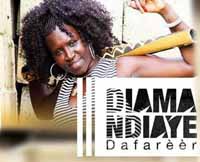
DIAMA NDIAYE
DAFAREER (Zhu Culture Productions)
Diama Ndiaye is Senegalese but has lived in Congo and elsewhere so there's a nice pan-African feel to her music which is also varied in styles and approach. She has been an actress, singer and dancer all her life, making her debut with the National Theatre of Senegal. Then she was a singer with the great Ouza and later Bira Guèye. On tour to Portugal in 1994 she left the Ballet Mansour and spent 8 years living there before moving to France. Following this she lived in the Democratic Republic of Congo before moving to Djibouti. The title means "He is lost" in Wolof, and is a song about street children which she encounters in African cities. She pleads with parents to care for their offspring. There is a degree of the big bombastic sound we associate with the early 80s Salif Keita albums, especially in her singing, but also some speedy soukous with accordion in "RDC-Senegal," where she sings loud and breathlessly like she is dancing with flailing arms while singing! Best of all are tracks like the title "Dafarèèr," which harken back to the sound of Ouza, with nice horn punctuation, simple rock instrumentation, and not too much of the synth strings. Otherwise she tends to get preachy which, even to a non-Wolof speaker, is a bit tedious.
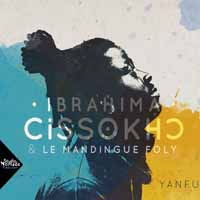
IBRAHIMA CISSOKHO & LE MANDINGUE FOLY
YANFU (Studio Nomade SNP2016-IC-01/2)
Another tradition-based album of Manding music, this one with some French (?) musicians jamming on it. Senegal and Gambia are referenced in the songs. Cissokho is the leader, singing (in English on "Dinala setsi") and playing kora. The engine of the band is electric bass, Western drumkit and a Peul flute. Guests include some of the musicians from the Sory Diabate Wali session: Petit Adama Diarra on djembe and acoustic guitar or three tracks and Sory Diabaté on balafon on one cut. In addition the renowned Nigerian saxophonist Orlando Julius steps up for one song, "Senegal", which aspires to funk, and Khadim Sene contributes sabar, which is a variable pitch or talking drum. Guillaume Lavergne's keyboards add sonic washes (including literally ocean sounds) which lend atmosphere without being overwhelming. The kora also uses electronic pedals for stereo and reverb which is a bit overdone on "Manduleen." The Peul flute is an acquired taste: fans of Jethro Tull will probably dig the "yelling and gasping into the mouth-hole" aspect. It's balanced between mbalax and rock but interesting to see where traditional music is headed.